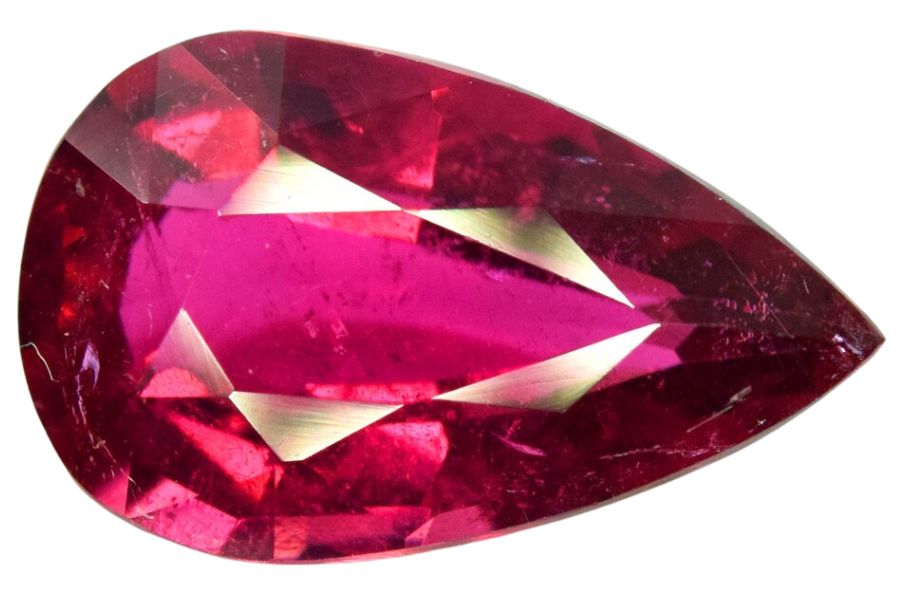From the deep crimson of rubies to the bright scarlet of cuprite, these colors tell a story of the planet’s history and beauty. Red rocks, gems, and minerals are some of the most captivating wonders found beneath the Earth’s surface.
Each red stone has its own unique properties and uses, making them not just a delight to look at but also valuable in various ways. Some are used in jewelry for their striking appearance, while others have practical uses in different industries.
We’ll dive into the fascinating world of red geological treasures, uncovering how they form, what makes them special, and why they continue to capture our imagination.
Red Gems and Crystals
Get ready to be captivated by the beauty and appeal of the red gems that we have listed below. We’re also sharing with you where you can find them and how you can identify these amazing gemstones.
Ruby – Al2O3
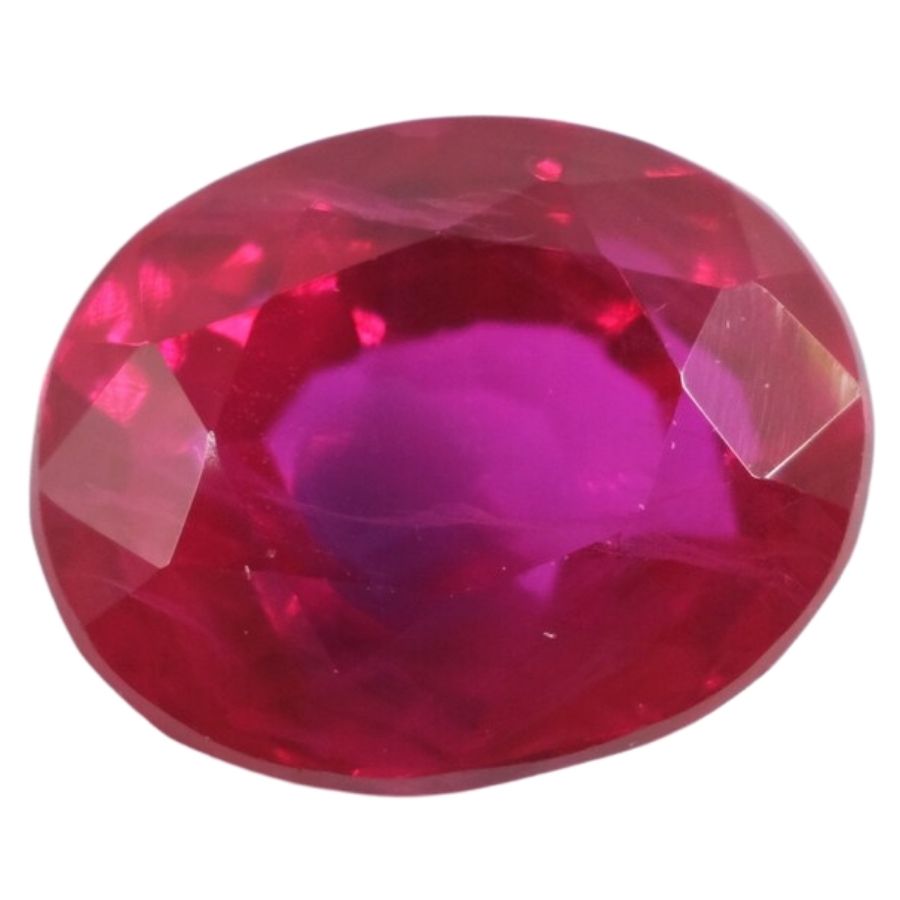
Ruby is a vibrant red gem that catches everyone’s eye with its stunning color. It’s used in all sorts of jewelry like rings, necklaces, and earrings because people love its bright red look.
This gem isn’t just pretty; it’s also very useful in making things like watches and medical instruments. Its toughness makes it great for everyday wear and in places where other gems might not last.
Beyond fashion and tools, rubies are also important in laser technology. They are used in laser devices for cutting, engraving, and even in medical surgeries, showing just how versatile this beautiful gem can be.
Fun Fact Did you know that ruby is the hardest gemstone next to diamonds? This makes it ideal for use in jewelry and other objects that will be subjected to wear and tear. So, not only is ruby captivating, but it is also incredibly durable.
Where ruby is found
Some of the most well-known ruby deposits are in Myanmar, known for producing some of the most sought-after rubies. Another place famous for its rubies is Thailand, where the stones have a unique, dark red tint.
In Africa, countries like Kenya and Tanzania are also known for their ruby mines. These African rubies are becoming more and more popular because of their beautiful colors and quality.
Vietnam and Afghanistan are also known for producing beautiful rubies.
How you can identify a ruby
Color
Rubies are famous for their deep, vivid red color. The color comes from the presence of chromium in the mineral corundum, giving rubies their iconic and striking hue.
Hardness
Rubies are incredibly hard, ranking 9 on the Mohs scale of mineral hardness, making them one of the hardest natural gems. This hardness allows them to be used in a variety of jewelry and industrial applications, as they resist scratching and wear.
Clarity
The clarity of rubies varies, but most have some inclusions, which are internal imperfections. High-quality rubies that are almost clear are extremely rare and valuable, with fewer inclusions generally leading to a more desirable and costly gem.
Refractive index
Ruby has a high refractive index, which means that it creates a brilliant, shimmering effect. The exact refractive index of a Ruby will depend on its chemical composition and other factors, but in general, it’s between 1.762 and 1.770.
Specific gravity
Ruby’s specific gravity is between 3.97 and 4.05. It’s heavier than most other gemstones of equal size.
Jasper – SiO2
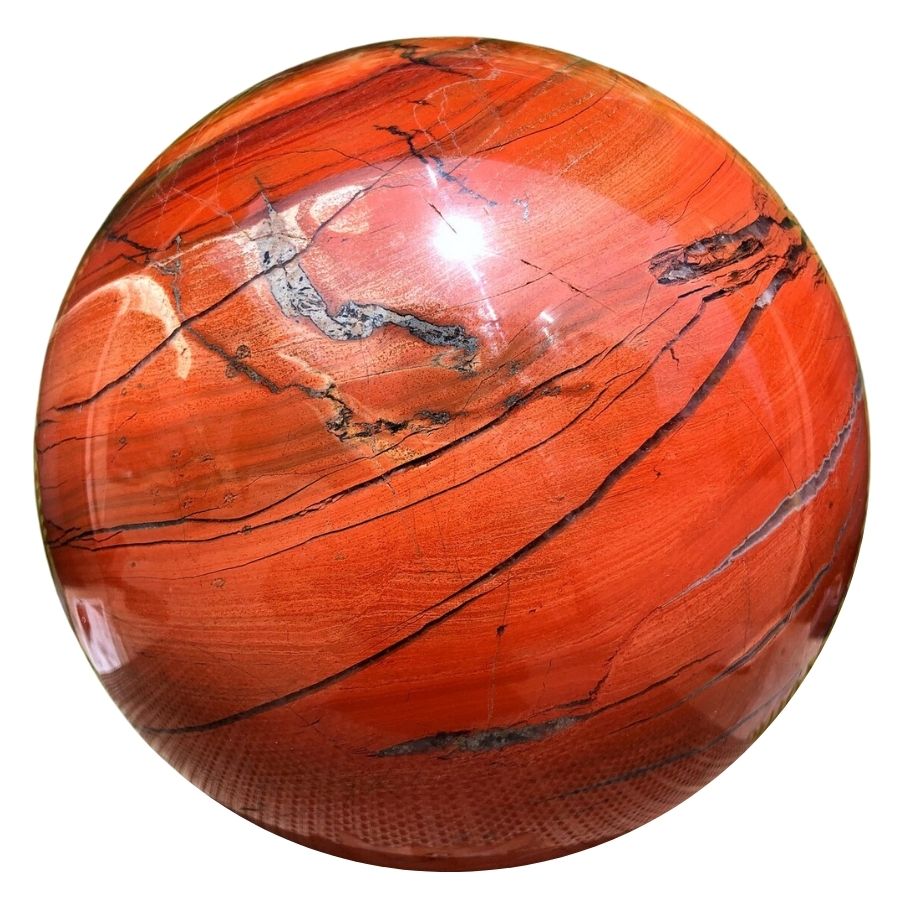
Jasper is a colorful stone that comes in many patterns and colors, making it a favorite for jewelry and decorative items. Its smooth surface and variety of colors make it popular for necklaces, bracelets, and even home decor.
Besides being used in jewelry, jasper is also carved into small sculptures or figures. Crafters and artists love to use jasper for its unique colors and the smooth, polished look it can have.
In history, people have used jasper for tools and carving because it’s so solid and easy to shape. Today, it’s still used for artistic and practical creations, showing just how versatile jasper can be.
Fun Fact For centuries, jasper has been thought to have medicinal value. It was used to treat digestive and respiratory problems. Some cultures would place jasper directly on the stomach or back or wear it as jewelry to receive its healing benefits.
Where jasper is found
Jasper is a common gem: it can be found in many parts of the world. It’s often found in sedimentary rock formations and is a result of the consolidation of sediment, such as sand, silt, and clay.
Some of the most notable locations for Jasper deposits include Madagascar, Brazil, Egypt, Australia, and the United States. If you’re interested in collecting jasper, you’ll have plenty of places to explore!
How you can identify jasper
Color
Jasper is known for its vibrant and diverse color palette! It can range from solid reds, to yellow, earthy greens, and browns with splashes of blue or purple.
Hardness
Jasper’s hardness is typically between 6.5 and 7 on the Mohs scale, which makes it a fairly durable gem. It’s ideal for use in jewelry and other decorative objects as it can withstand some wear and tear without being easily scratched or damaged.
Clarity
Jasper is typically an opaque stone, meaning it doesn’t let light pass through, which is a key feature in its appearance and use in jewelry. Its opaque quality, along with its rich, varied colors and patterns, contributes to its popularity and distinct beauty.
Specific gravity
Jasper’s specific gravity is around 2.5 to 2.9, which is why it’s considered a relatively heavy mineral for its size.
Carnelian – SiO2
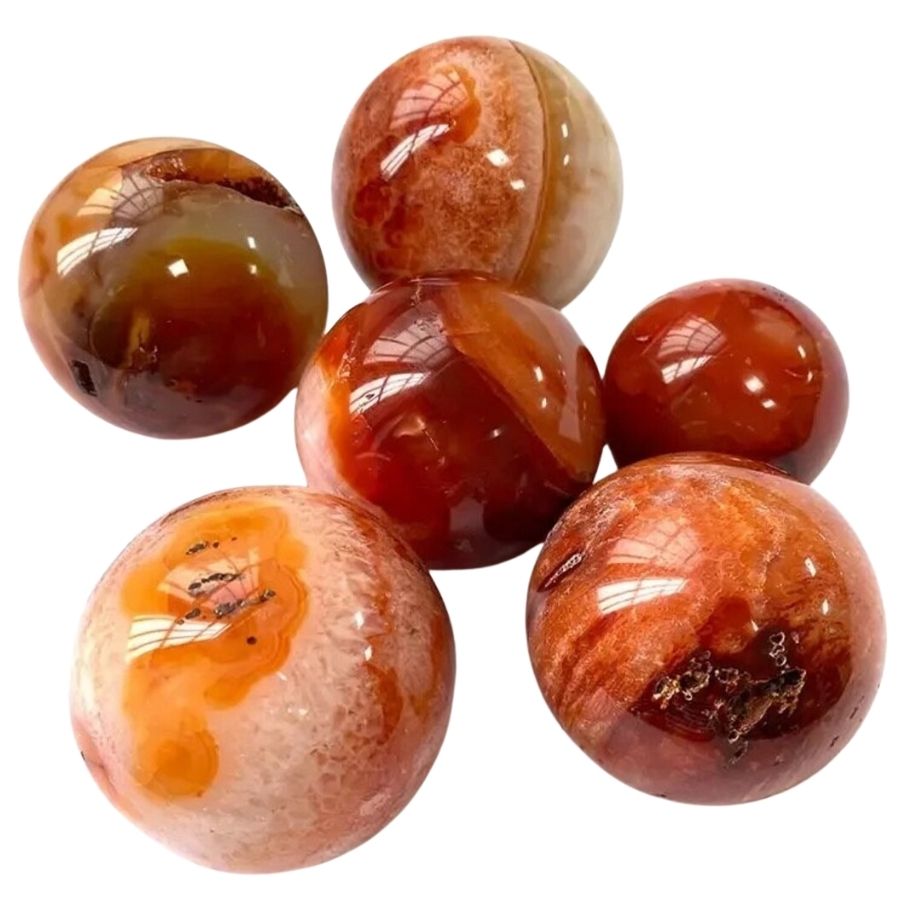
Carnelian is a beautiful orange-red stone that’s been used for thousands of years in jewelry and decorative objects. Its warm color makes it a popular choice for rings, bracelets, and necklaces.
This stone isn’t just pretty to look at; it’s also used for carving into beads or small statues. Artists and craftspeople love carnelian for its smooth texture and vibrant color, which can really make their work stand out.
In the past, carnelian was used to make seals and signets because wax doesn’t stick to it. Today, people still appreciate it for its beauty and versatility in different crafts and jewelry making.
Fun Fact
Carnelian has adorned jewelry since the 4th millennium B.C., with beads discovered in early Neolithic Bulgarian graves and used extensively by ancient Egyptians and Greeks for beads, cabochons, and intaglios.
This vibrant stone was a staple in ancient adornments, often set in gold for Egyptian ornaments or crafted into signet rings by the Greeks and Romans for sealing letters.
Where carnelian is found
Carnelian is often found in India, Brazil, and parts of Africa, where the conditions are just right for forming this beautiful stone.
In these places, it’s typically found in volcanic rocks or places where hot water has circulated, dissolving and then depositing minerals.
How you can identify carnelian
Color
Carnelian is known for its warm and inviting colors, ranging from pale orange to a deep, almost reddish-brown. The stone’s color comes from iron oxides within the chalcedony, giving it those rich, varying shades.
Hardness
Carnelian has a good hardness, scoring about 7 on the Mohs scale, which means it’s pretty durable for everyday wear. This hardness makes it great for all kinds of jewelry, like rings and bracelets, because it can resist scratches better than softer stones.
Clarity
Carnelian is usually found with a translucent quality, allowing some light to pass through and highlight its rich color. Most pieces have a smooth, even texture that looks great when polished.
Refractive index
Carnelian has a refractive index of around 1.54. This bending of light helps give carnelian its shiny, glossy look that catches the eye.
Specific gravity
Carnelian has a specific gravity of around 2.6. Knowing the specific gravity helps people identify carnelian and understand how it will feel when worn or held.
Garnet – R3R2(SiO4)3
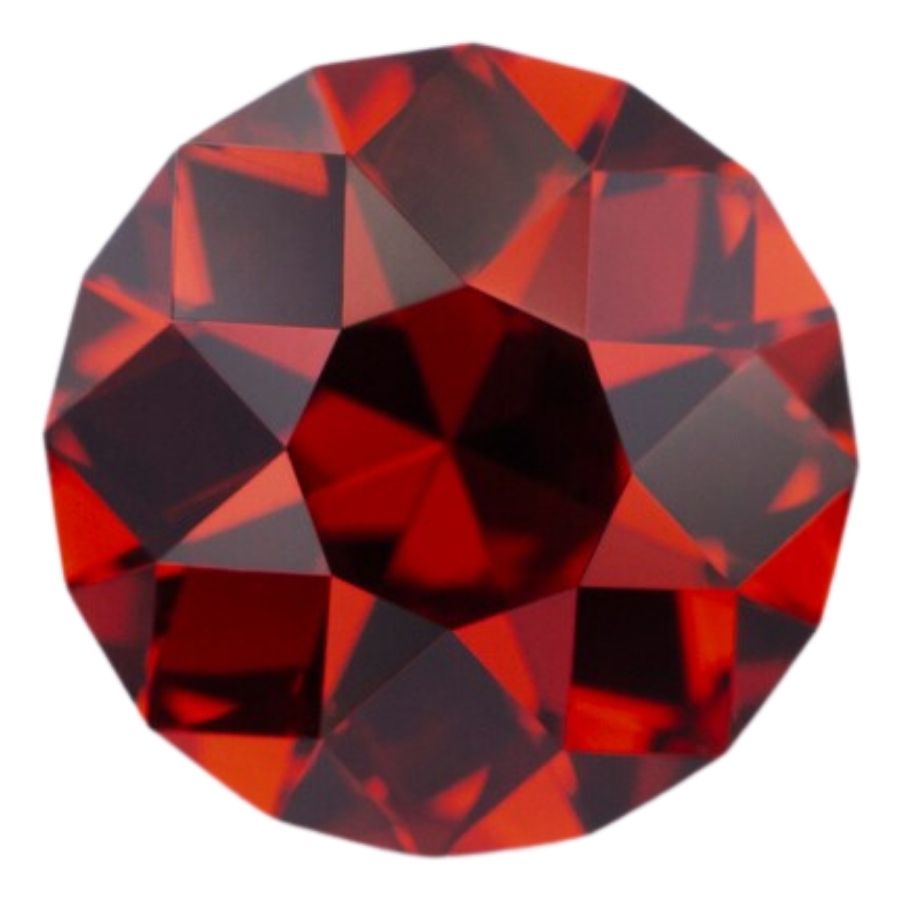
Garnet is a fascinating and versatile mineral that comes in a rainbow of colors. It’s most commonly known for its deep red variety, but it can also be found in green, orange, and even purple hues.
This mineral is not just pretty to look at; it has many practical applications as well. For example, garnet is used as an abrasive in waterjet cutting and sandblasting, where its toughness helps shape, cut, or clean various materials.
Garnet is also popular in jewelry, where its array of colors and luster make it a favorite choice for rings, necklaces, and bracelets. Beyond adornment, it’s used in certain industrial processes, like filtration, due to its specific physical properties.
Fun Fact: For the last 150 years, garnet has proven to not only be captivating but also to be an effective industrial material. In fact, it's been used in abrasives, filters, and waterjet cutters.
Where garnet is found
Garnets can be found in many parts of the world, including Africa, Russia, South America, the US, and many more.
They’re commonly found in metamorphic rocks like schist and mica and can also be found in placer deposits, formed from weathering and erosion of bedrock.
Some of the most popular types of garnets, like almandine and pyrope, are abundant and can be found in large deposits, while other rarer varieties like demantoid and tsavorite are much harder to come by.
How you can identify garnet
Color
Garnets come in many colors! They can be red, orange, yellow, green, pink, purple, brown, black, and more. But its most common color is rich, deep red that’s due to the presence of iron and aluminum.
Some also have a color-change effect, where the color appears different under different light sources.
Hardness
Garnet is known for its good hardness, typically ranging from 6.5 to 7.5 on the Mohs scale, making it durable and resistant to scratches.
This hardness makes it suitable for various types of jewelry and industrial applications, where it can be used as an abrasive.
Clarity
Garnet stones can vary in clarity from transparent to almost opaque, with the clearer varieties often used in jewelry.
The transparent or translucent garnets are particularly prized, allowing light to pass through and enhance their color and brilliance.
Refractive index
Garnet’s refractive index ranges from 1.7 to 1.9. This is high enough to give it good dispersion (the separation of light into its component colors), which results in a pleasant, sparkling appearance.
Specific gravity
Garnet’s specifc gravitiy ranges from 3.5 to 4.3, which means it’s relatively heavy for its size.
Spinel – MgAl2O4
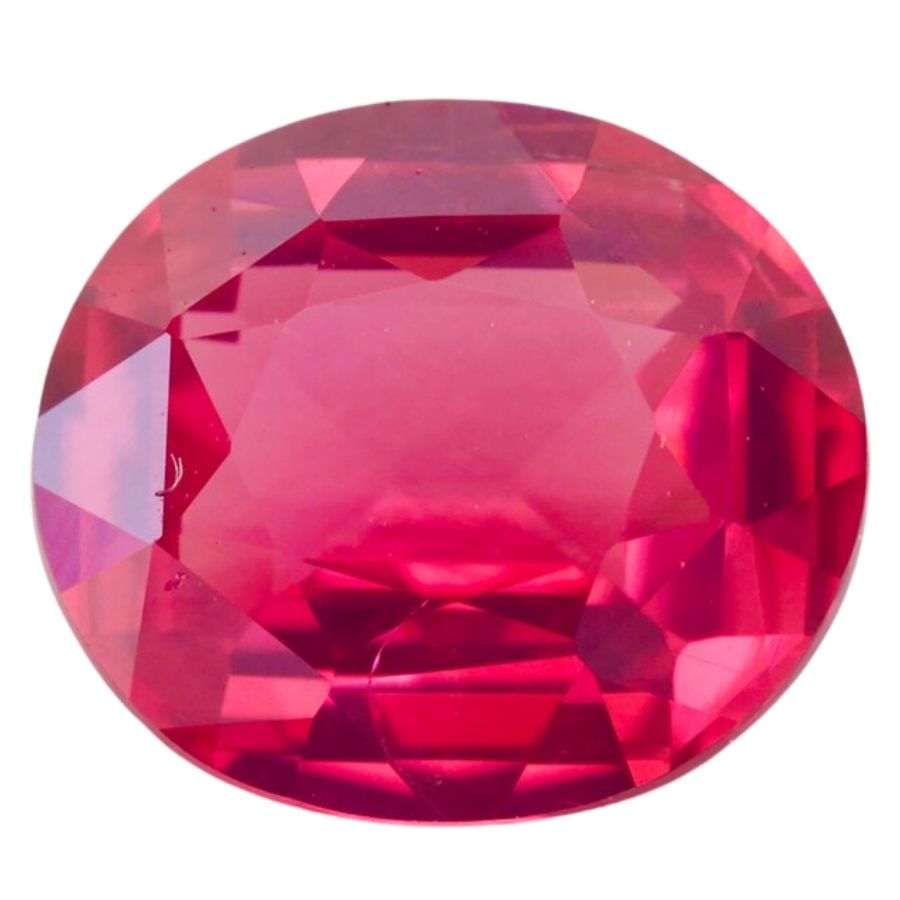
Spinel is a gemstone that comes in many colors, but it’s especially known for its bright reds, pinks, and blues. It’s often used in jewelry because of its beauty and the way it shines in the light.
This gem is not just for looking pretty; it’s also used in various industries. For example, because of its toughness, it’s used in the production of certain ceramics.
Another cool thing about spinel is that it’s sometimes mistaken for other gems like ruby or sapphire. This is because of its similar look and the wide range of colors it comes in, making it a versatile and attractive choice for many.
Fun Fact: Spinel's beauty wasn't always recognized. In fact, it was often mistaken for other precious gems like sapphire. It was even called the "poor man's ruby". It wasn't until the late 19th century that spinel was properly identified, recognized, and appreciated as a unique, captivating gem of its own.
Where spinel is found
Some of the most notable and rich sources of Spinel include Myanmar, Sri Lanka, Tanzania, Madagascar, and Vietnam. It can be found in different types of rocks and formations, including metamorphic, ultramafic, and placer deposits.
Spinels are typically found as small to large crystals, but they can also be found in massive forms and aggregates.
How you can identify spinel
Color
Spinel has many different colors – red, pink, purple, blue, green, yellow, and orange – due to the different elements within the crystal structure.
In fact, it can range from a deep, rich hue to a light pastel shade, with some stones having a single color and others exhibiting multicolor (color-zoning).
Hardness
Spinel has a Mohs hardness of 8, making it a relatively hard gem. Its hardness means it”s durable enough for use in jewelry, but still relatively easy to work with for cutting and polishing.
Clarity
Spinel’s clarity varies from crystal clear to translucent to opaque, depending on its origin and impurities. Some specimens can be quite clear and transparent while others can be cloudy or have inclusions, which reduce its transparency.
Refractive index
Spinel’s refractive index is around 1.7 to 1.9, so it has a moderate light dispersion. This, combined with its high clarity, makes it a captivating gem for jewelry.
Specific gravity
Spinel’s specific gravity is around 3.60 to 3.65, which is relatively high. Compared to most gems, it is heavy for its size.
Rubellite – Ca(Li,Al)3Al6B3Si6O27(OH)3(OH,F)
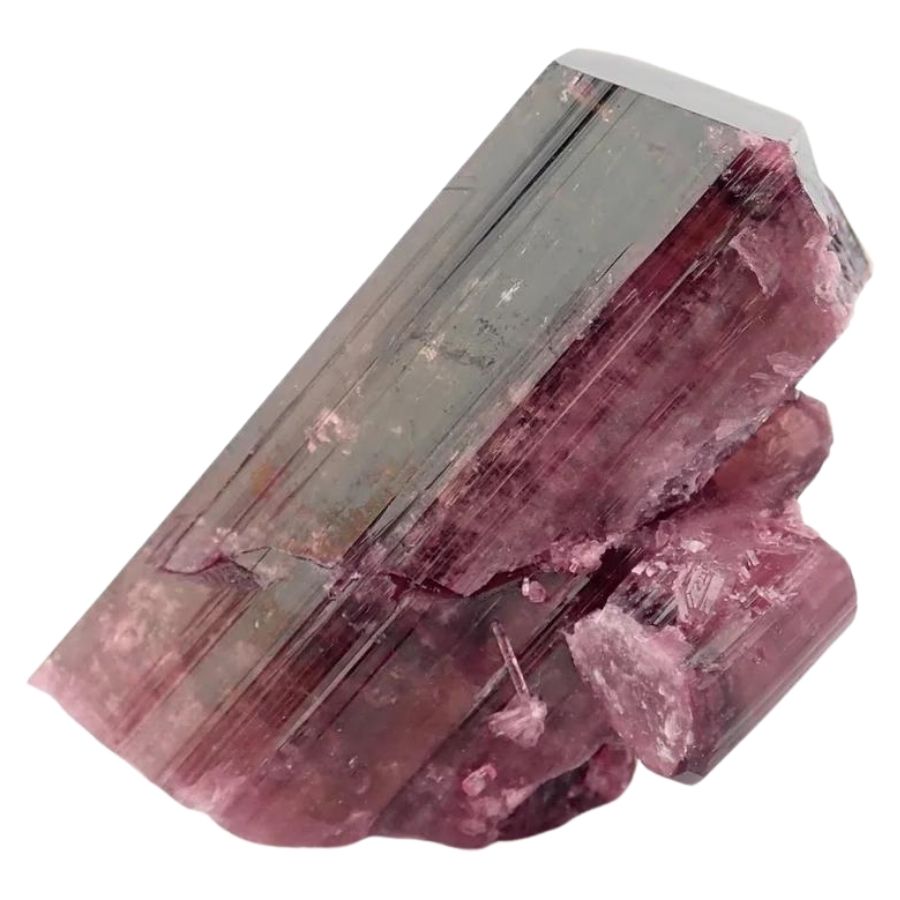
Rubellite is a beautiful gemstone known for its vibrant pink to red colors. It’s a type of tourmaline, which is a group of minerals that come in a rainbow of colors, but rubellite stands out with its warm hues.
In the world of jewelry, rubellite is a popular choice because of its striking color. It’s used in everything from rings and necklaces to earrings and bracelets, adding a splash of color to any piece.
Aside from being a gemstone, rubellite doesn’t have many practical uses, but it’s greatly admired by collectors and gem enthusiasts.
Its rich color and beauty make it a prized addition to any collection, showcasing the wonderful variety found in the natural world.
Fun Fact: Rubellite, as a variety of tourmaline, exhibits strong pleochroism, meaning it shows two different colors - a primary and a secondary - that can vary in intensity when viewed from different angles. This effect is due to its double refraction, making it one of the most vividly two-colored gems among all stones.
Where rubellite is found
Rubellite is found in places rich with other gemstones, often located in granite and metamorphic rocks. Some well-known sources include Brazil, Madagascar, and the United States, where the perfect conditions for forming rubellite exist.
How you can identify rubellite
Color
Rubellite boasts a stunning range of colors from deep, vivid reds to softer shades of pink, making it stand out in the world of gemstones. This vibrant palette is due to trace elements in its composition, giving each stone a unique and captivating hue.
Hardness
Rubellite, as a type of tourmaline, has a hardness of 7 to 7.5 on the Mohs scale, making it quite durable and suitable for various types of jewelry. This hardness allows it to withstand daily wear while maintaining its beautiful shine and structure.
Clarity
The clarity of rubellite can vary greatly, with some stones being almost inclusion-free and highly transparent, while others may contain visible inclusions or be more translucent.
Generally, the more transparent and inclusion-free the rubellite, the more valuable and sought after it is in the gem market.
Refractive index
Rubellite, like other varieties of tourmaline, has a significant refractive index, typically ranging between 1.62 and 1.68. This high refractivity contributes to its brilliant sparkle and the intensity of color seen when light passes through it.
Specific gravity
Rubellite has a specific gravity typically ranging between 3.06 and 3.10. This characteristic helps gemologists and enthusiasts identify rubellite and distinguish it from other gemstones.
Pezzottaite – Cs(Be2Li)Al2Si6O18
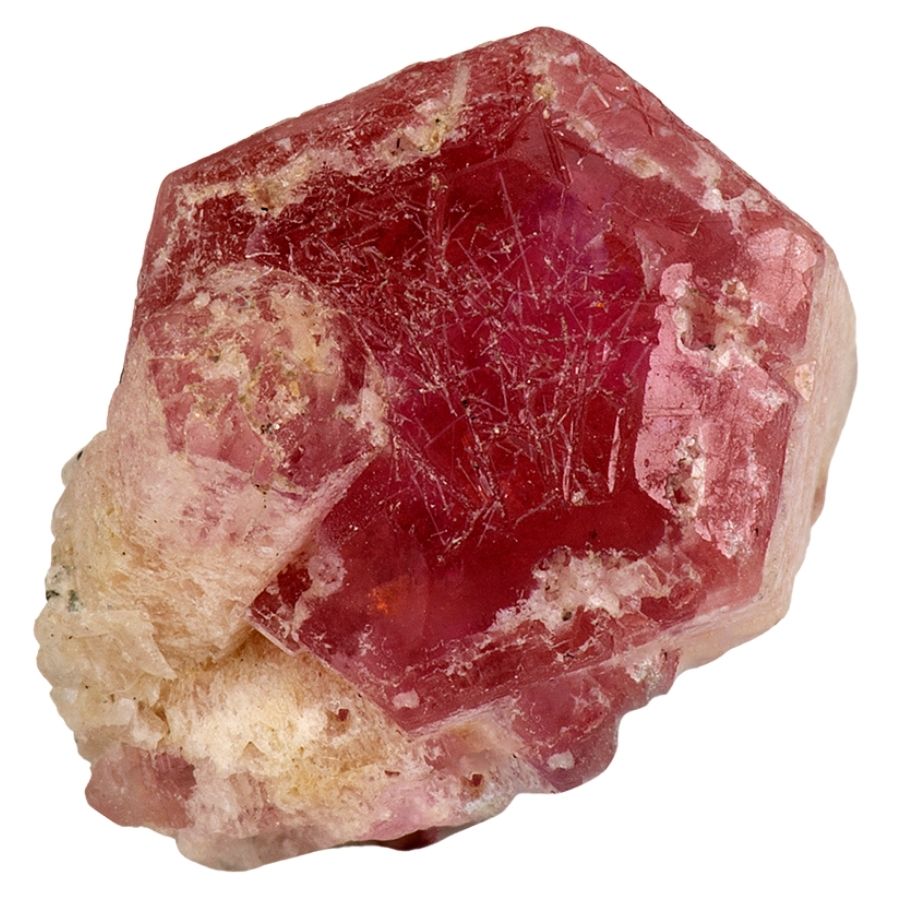
Pezzottaite is a rare gemstone that’s known for its striking raspberry to purple color. It’s a relatively new discovery in the world of gemstones, making it a unique and exciting find for collectors and jewelry lovers.
In jewelry, pezzottaite is often cut into various shapes to highlight its beautiful color and sparkle. Due to its rarity, pieces featuring pezzottaite are considered quite special and are often sought after by those who love unique and rare gems.
Besides its use in jewelry, pezzottaite doesn’t have a wide range of practical applications. However, its rarity and distinctive color make it a prized specimen for mineral collectors and enthusiasts.
Fun Fact Initially believed to be a new type of beryl, pezzottaite was later identified as a distinct mineral due to its unique trigonal crystal structure and the presence of cesium and lithium, setting it apart from beryl. This discovery clarified that its earlier trade names, suggesting a relation to beryl, were in fact misleading.
Where pezzottaite is found
Pezzottaite is a relatively new discovery in the world of gemstones, first identified in Madagascar in 2002. Since then, it has also been found in Afghanistan, adding to the list of places where this rare gem can be located.
How you can identify pezzottaite
Color
Pezzottaite is celebrated for its unique raspberry pink to deep rose-red color, a hue that sets it apart in the gem world.
This striking color, sometimes showing hints of purple, is due to the presence of manganese in the mineral, giving it a vibrant and attractive appearance.
Hardness
Pezzottaite ranks at 8 on the Mohs scale of mineral hardness, indicating that it’s quite a hard and durable gemstone. This level of hardness makes it suitable for use in various types of jewelry, as it can resist scratches and everyday wear quite well.
Clarity
The clarity of pezzottaite varies, with some stones displaying high transparency and minimal inclusions, while others may be more included or translucent.
These variations in clarity can significantly affect the gemstone’s value, with clearer, more transparent pezzottaite being particularly prized by collectors and jewelers.
Refractive index
Pezzottaite has a refractive index ranging between 1.60 and 1.64, contributing to its bright luster and the way it sparkles when light strikes it.
Specific gravity
Pezzottaite has a specific gravity typically between 2.9 and 3.3, indicating it’s denser than many other gemstones.
Red Rocks
Durability, versatility, and beauty — red rocks have them all! Buckle up and be ready to get to know them here.
Jaspillite – Fe2O3 SiO2
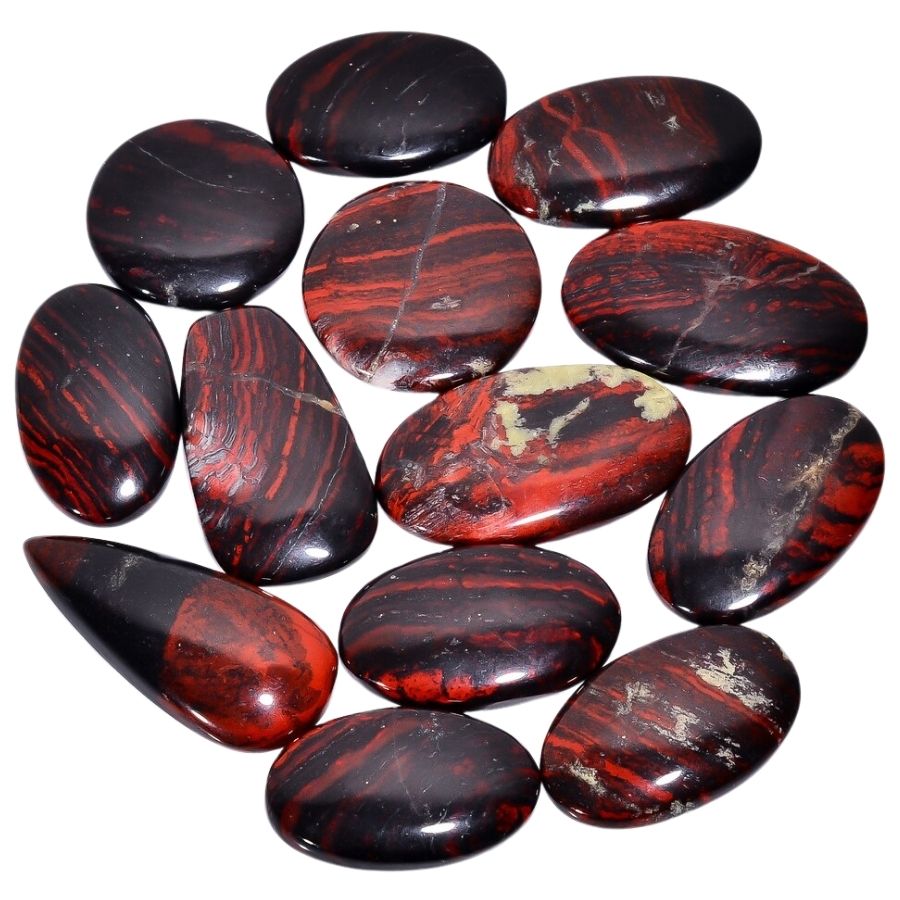
Jaspillite is a rock that’s made up of bands of iron and silica, creating a striking pattern of red, yellow, and gray colors. It’s part of the iron formation family and plays a big role in the mining industry.
This rock is important because it’s a source of iron ore, which is used to make steel. The iron bands in jaspillite are extracted and processed to produce metal for buildings, cars, and many other things.
Not only is jaspillite used for its iron, but it’s also appreciated by collectors and decorators for its unique, banded appearance. Its mix of colors and patterns makes it a cool piece to display or use in various crafts and home decor.
Fun Fact:
Jaspillite is widely used for scientific research to study the Earth's history. Its red and green layers are of great interest to geologists as they provide clues about the conditions that existed when the rock was formed.Where jaspillite is found
Jaspillite is in various places across the world, but it’s most commonly found in Precambrian rock formations.
These formations are some of the oldest rocks on the planet and are located in many countries, including Canada, South Africa, Russia, and Australia.
How you can identify jaspillite
Color
Jaspillite has a unique and recognizable layers of red and green. The red color comes from iron oxide (rust), while the green color is due to its iron-rich minerals. These layers alternate in a rhythmic, banding pattern, giving the rock a captivating look.
Hardness
Jaspillite has a hardness of 6 to 7 on Mohs Scale as a results of it high iron content. This makes it suitable for a variety of uses (from ornamental items to jewelry to scientific research) as it can withstand wear and tear.
Clarity
Jaspillite typically presents as an opaque rock with a fine-grained texture, due to its composition of iron and silica layers.
The distinct, alternating bands of color in jaspillite contribute to its overall appearance rather than its clarity, making it prized for its striking visual patterns.
Refractive index
Jaspillite’s refractive index is typically around 1.5 to 2, which is relatively low. While it’s not typically prized for its optical properties as it is an opaque rock, it sure is eye-catching!
Specific gravity
Jaspillite’s specific gravity is typically around 2.5 to 3. This is relatively high, which means that this rock is relatively heavy for its size. This means it’s a good choice for uses where strength and durability are important, such as in sculptures.
Cinnabar – HgS
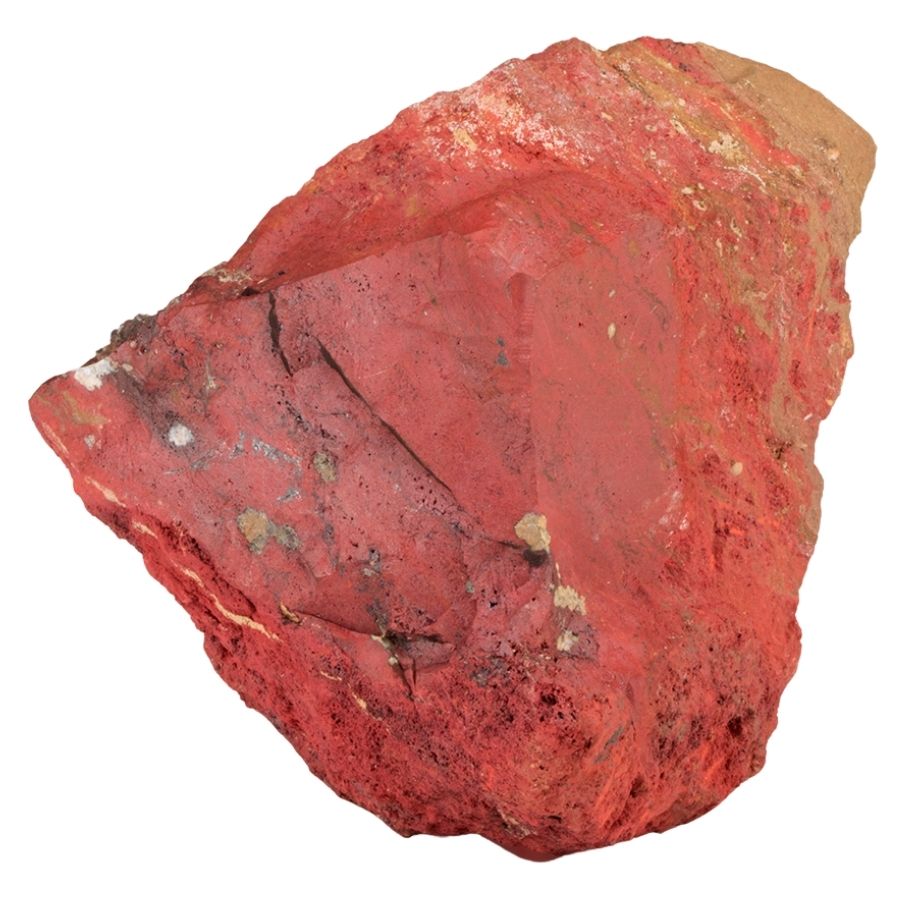
Cinnabar is a vibrant red mineral that’s mostly known for being the main source of mercury. People have used it for thousands of years to extract mercury, which has a variety of uses in different industries.
One of the traditional uses of cinnabar was as a pigment. Its bright red color was perfect for painting and decorating everything from pottery to temples.
Even though it’s not as commonly used for pigments today, cinnabar continues to be important for mercury extraction. This makes it valuable in producing things like thermometers, dental amalgams, and even in some electrical switches.
Fun Fact: While still valued for its beautiful color, cinnabar is also recognized now as a toxic mineral, so it's important to handle it with care. Despite its toxicity (which only comes out when temperatures rise), it's still used in modern society, particularly in the production of pigments for paints and dyes.
Where cinnabar is found
Cinnabar is commonly found in veins and deposits formed by hydrothermal activity. Specifically, it’s usually in volcanic areas, or near hot springs, as it’s a product of volcanic activity.
It can be found in many parts of the world, including Italy, Spain, USA, China, Peru, and Mexico.
How you can identify cinnabar
Color
Cinnabar’s color is a vivid red or vermillion, almost like crimson. It’s the color of a sunset, with an intensity that is hard to match.
Hardness
Cinnabar’s hardness is 5.5 to 6 on the Mohs scale. It can’t be scratched with a fingernail, but it can be scratched with a metal blade or coin. Cinnabar’s hardness makes it useful for jewelry and decorative items as it won’t easily wear down or break.
Clarity
Cinnabar generally exhibits a translucent to opaque clarity, often with a bright, adamantine luster that highlights its deep, red color. The stone’s clarity can vary, but it is typically prized for its vibrant hue and lustrous finish.
Refractive index
Cinnabar’s refractive index is typically between 2.7 to 2.9, which means it has a low absorption of light. However, it has a high dispersive power, meaning it can split white light into its component colors, making it great for optical applications.
Specific gravity
Cinnabar’s specific gravity is 8.1 to 8.2. This is slightly higher than most heavy rocks, and is not usually affected by temperature or pressure. It’ll remain relatively constant under normal conditions.
Breccia – Multiple minerals
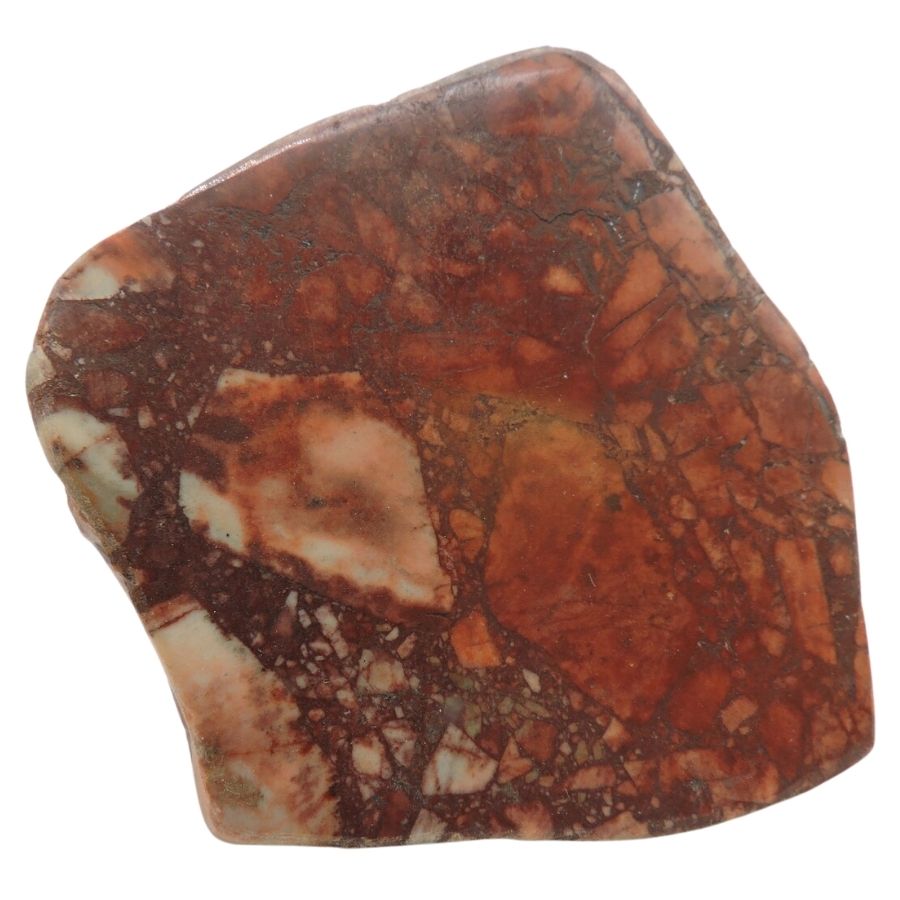
Breccia is a fascinating rock made up of broken fragments of minerals or rocks cemented together by a fine-grained matrix.
This unique composition gives breccia a very distinctive appearance, often characterized by angular pieces of different sizes and colors.
In construction, breccia is valued for its decorative appearance and is used in things like countertops, flooring, and wall tiles. Its varied patterns and colors make each piece unique, adding a natural, earthy element to buildings and homes.
Breccia also has applications in landscaping and sculpture. Its durability and unique texture make it a popular choice for garden paths, rockeries, and artistic carvings, showcasing the versatility of this naturally occurring rock.
Fun Fact: There are different names for different kinds of Breccia, depending on the type of rock its fragments were produced from. For example, when lava picks up rock fragments, it forms "Volcanic Breccia," but when lava flow is halted during movement, it forms "Flow Breccia." There is also "Sandstone Breccia," "Granite Breccia," "Basalt Breccia," and others.
Where breccia is found
Breccia is found all over the world, in many different geological settings. Some of the most notable locations include the Andes Mountains in South America, the western United States, and the mountains of Australia and New Zealand.
How you can identify breccia
Color
Breccia’s color is highly variable as it’s made up of fragments of rocks, minerals, and other material, which can have different colors themselves. Its color can range from red, pink, gray, brown, yellow, and green to black and practically any other color.
Hardness
Breccia’s hardness varies depending on the type of rock fragments it consists of. Typically, though, it has a hardness range of 6-7 on the Mohs scale, making it relatively hard and durable.
Clarity
Clarity is not a defining characteristic of Breccia since it’s a type of rock. But it’s often described as porous or clumpy, with visible fragments of different rocks and minerals in its matrix.
Refractive index
Breccia’s refractive index varies depending on the mineral composition, but it usually falls in the range of 1.48 – 1.68.
Specific gravity
Breccia’s specific gravity varies, as it’s a rock made of broken fragments of different minerals (some dense, some lighter) held together by a matrix. But, on average, it’s around 2.5-2.7 (g/cm^3), so it’s heavy for its size.
Red Minerals
If the red gemstones and rocks have amazed you, the following red minerals will surely hook you some more. Some of these may be quite new to you, so take in as much as you can from our list!
Erythrite – (Co3(AsO4)2 · 8H2O)
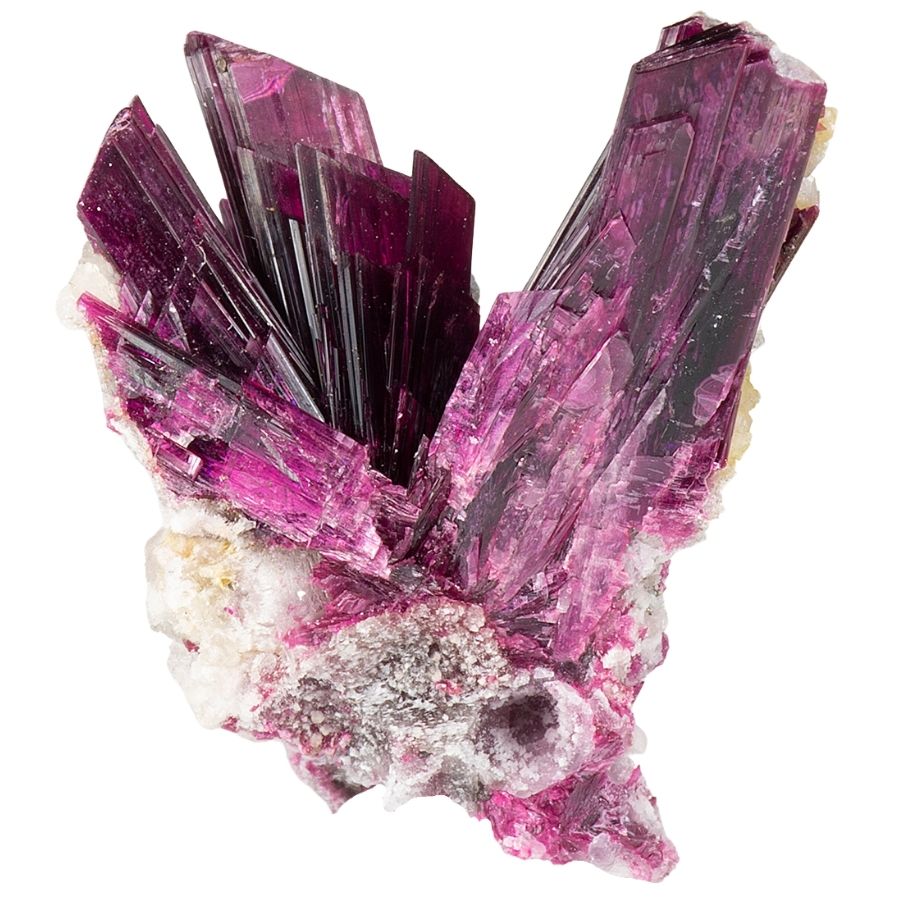
Erythrite is a mineral that has a vibrant, red-purple color that makes it a prized specimen in the mineral world. It was first discovered in 1832 by French chemist Jean-Baptiste Boussingault.
Erythrite has a long history of use in the production of pigments for ceramic glazes and dyes for textiles. It was also used in the production of batteries and electroplating.
But despite its practical uses, it’s mostly valued for its stunning color and rarity. In fact, some specimens of erythrite can fetch high prices at mineral auctions due to its beauty and scarcity.
Fun Fact Erythrite is also called "Cobalt Bloom" by miners because it is a hydrated cobalt arsenate mineral or a weathering product of minerals that contain cobalt.
Where erythrite is found
Erythrite is found in various regions across the world. It’s often discovered in secondary deposits, near hydrothermal veins, or in cobalt-rich skarn deposits.
Some of the well-known locations of erythrite are Germany, France, Morocco, Namibia, Australia, and the US. It’s also been found in areas with volcanic activity.
How you can identify erythrite
Color
Erythrite’s color can vary from red, pink, to deep purple. This mineral gets its color from the presence of cobalt.
Hardness
Erythrite’s hardness can be considered to be on the softer side, typically around 2.5 to 3 on the Mohs scale. Its softness makes it easily breakable and less suitable for commercial uses.
Clarity
Erythrite is typically translucent to opaque, with a vitreous to pearly luster that enhances its rich, pink to purple-red color.
Refractive index
Erythrite has a refractive index ranging from approximately 1.62 to 1.7, which is relatively high and contributes to its noticeable luster and color depth.
This refractive quality means it can sparkle and shine under light, making its vivid pink to purple-red hues even more striking.
Specific gravity
Erythrite has a specific gravity of 3.06. This density, characteristic of the mineral, helps in identifying erythrite and understanding its substantial feel and heft compared to its size.
Chondrodite – Mg5(SiO4)2F2
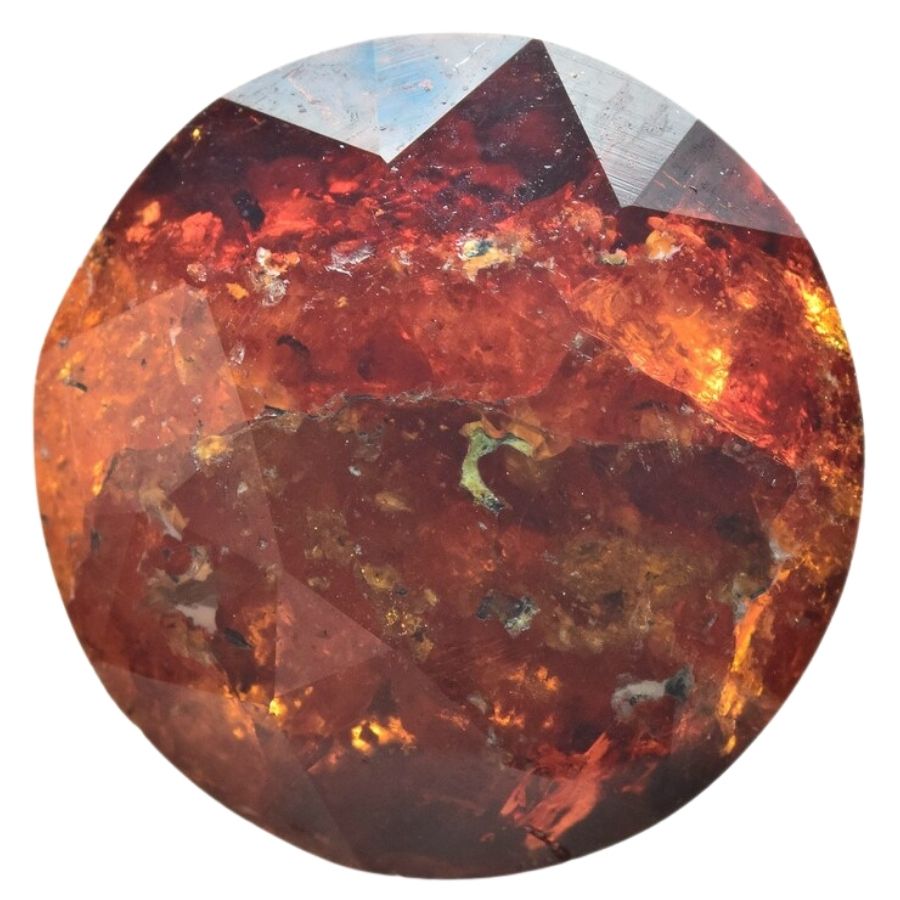
Chondrodite is a rare mineral known for its yellow, orange, or red-brown colors. It’s often found in limestone and marble, where it has formed under high-pressure conditions.
This mineral is not commonly used in everyday items but is of interest to scientists and collectors. Its presence can tell geologists a lot about the conditions and history of the rocks it’s found in.
While chondrodite is mainly a subject of study rather than a material for making things, its unique properties and formation make it fascinating. Collectors prize it for its rarity and the beautiful way it looks when cut and polished.
Fun Fact
Chondrodite has been discovered in a type of meteorite called a chondrite.Where chondrodite is found
Chondrodite is found in several places around the world, including parts of Europe, Asia, Africa, and North America. It’s usually found in metamorphic rocks, such as marbles and schists, and can also be found in some types of volcanic rocks.
Some of the most famous locations for chondrodite include Russia, Italy, and Madagascar. The mineral can also be found in smaller quantities in other countries as it’s pretty widespread.
How you can identify chondrodite
Color
Chondrodite is typically found in a range of warm hues from yellow to orange and sometimes a reddish-brown, offering a distinctive palette in the mineral world.
Its color can vary depending on the specific chemical composition and the environment where it formed.
Hardness
Chondrodite has a hardness of 6 to 6.5 on the Mohs scale, making it fairly durable and resistant to scratches.
This level of hardness means it can be used in certain types of jewelry and is suitable for various collectors’ items where a certain degree of durability is beneficial.
Clarity
Chondrodite’s clarity can range from transparent to translucent. It’s known to have inclusions or small impurities, which can affect the clarity of the stone. The clarity can also change based on the presence of different minerals in the mineral.
Refractive index
The refractive index of Chondrodite varies, but generally falls between 1.58 to 1.67. It’s considered a single refractive mineral, which means that it doesn’t have the double refraction that some other minerals have.
Specific gravity
Chondrodite’s specific gravity of 3.15, making it a mineral of average density compared to others. It’s moderately heavy and has a good resistance to abrasion.
Cuprite – Cu2O
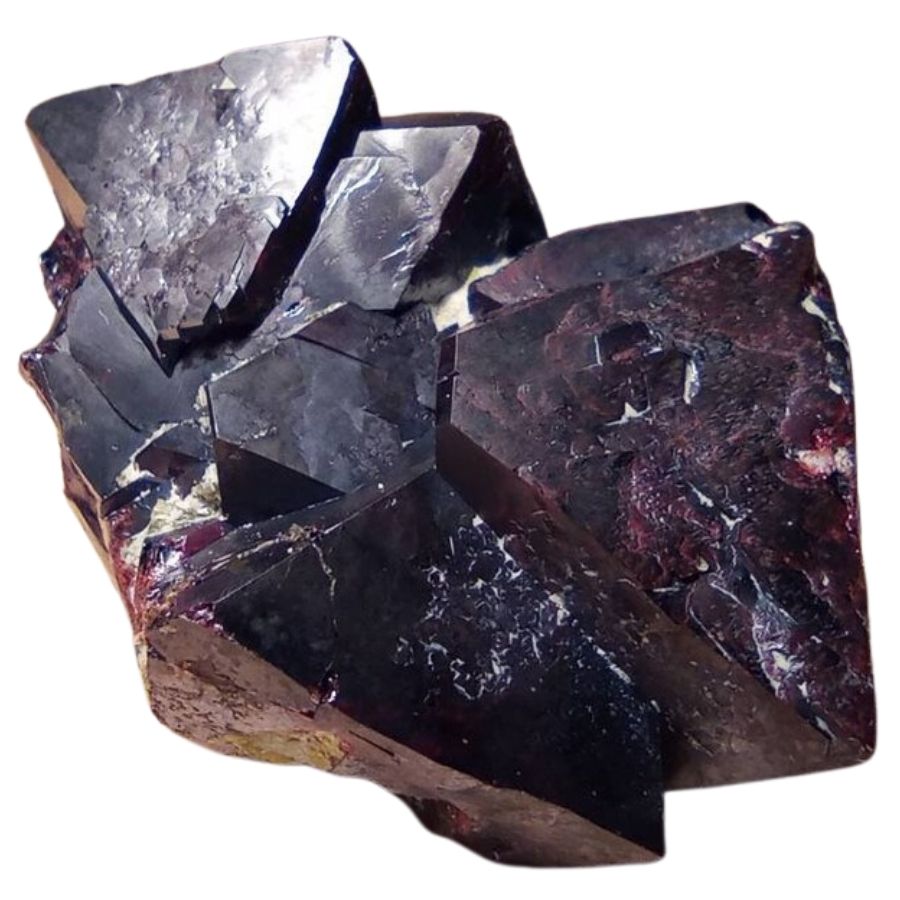
Cuprite is a striking mineral known for its deep red color that sometimes looks almost metallic. It’s mainly made up of copper, which gives it that rich, red hue people find so attractive.
In the world of practical uses, cuprite is important because it is a major ore of copper. People extract copper from it to use in electrical wiring, plumbing, and even in making coins.
Besides its role in copper production, cuprite is sometimes cut into gemstones for collectors who appreciate its color and luster. However, it’s quite rare to find it in jewelry due to its softness and rarity compared to more common gemstones.
Fun Fact:
Cuprite was used as a red pigment in ancient Egyptian art and is also thought to have been used by the Maya and Aztecs. That’s why it’s sometimes referred to as "Egyptian Red" or "Aztec Red."Where cuprite is found
Cuprite is found in England, Russia, Chile, the Congo, and several other places in the world. It’s a rare mineral, and it’s mostly found in copper mines and deposits along with other copper oxide minerals.
In England, the copper mines of Cornwall where it was first discovered are still considered some of the best places to find high-quality specimens of cuprite today. So while cuprite is very rare, it’s not impossible to still find it!
How you can identify cuprite
Color
Cuprite is known for its rich, reddish-brown color that is due to the presence of copper. That’s also why it’s often referred to as “ruby copper” or “red copper.” This color can range from a light, brick-red to a dark, almost blackish-red.
Hardness
Cuprite’s hardness is relatively low, with a rating of 3.5 to 4 on the Mohs scale. Thus, it can be easily scratched or damaged. Despite this, it’s still a fascinating gem that’s prized for its beauty and uniqueness.
Clarity
Cuprite typically exhibits a translucent to opaque clarity, often with a submetallic to adamantine luster that enhances its deep red color. Its clarity, combined with its rich hue, makes it a unique and attractive mineral for collectors and enthusiasts.
Refractive index
Cuprite has a high refractive index of 2.85, which contributes to its notable optical properties, including its deep red color and metallic luster.
This high refractivity is one of the reasons cuprite is so sought after by collectors, as it enhances the stone’s overall brilliance and depth of color.
Specific gravity
Cuprite’s specific gravity is around 6.14, which is considered relatively high. The high copper content of this gem makes it heavy and substantial compared to other gems.
Crocoite – PbCrO4
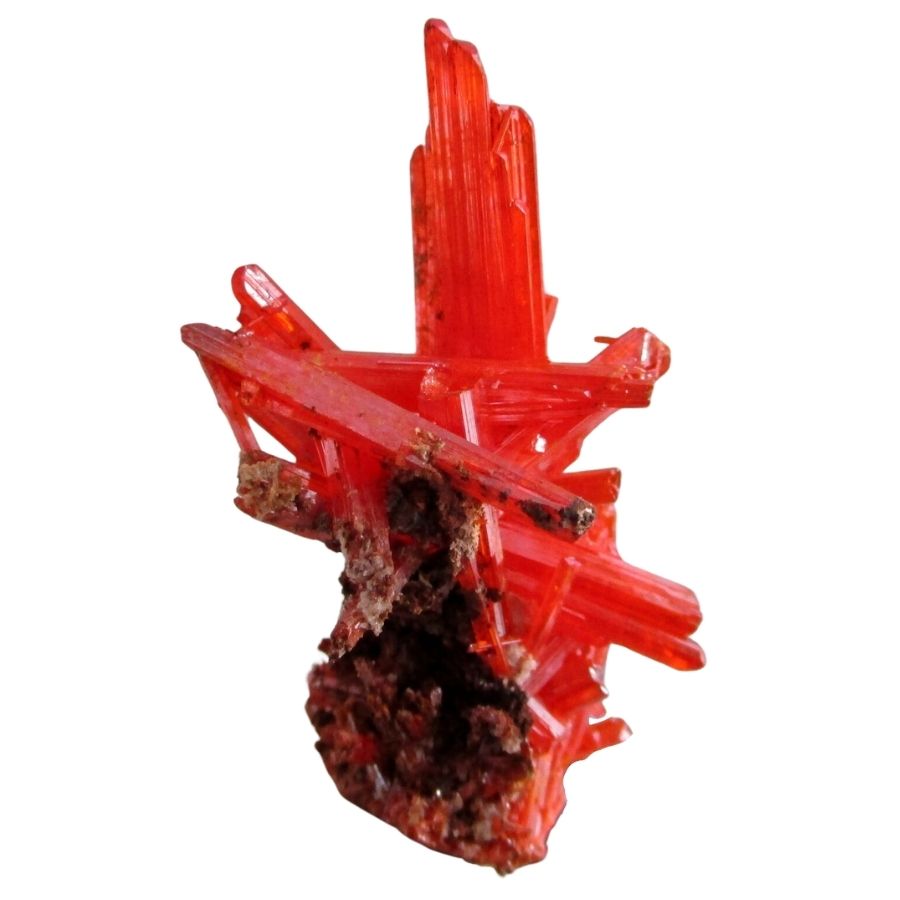
Crocoite is a striking mineral known for its bright orange-red crystals that are a wonder to see. It’s mainly made of lead chromate, which gives it those fiery colors that catch your eye.
While it’s not widely used today due to its lead content, crocoite played a historical role in paint production. Its intense color was once prized for creating vivid orange and red pigments before safer alternatives were found.
Today, crocoite is primarily appreciated by mineral collectors and enthusiasts for its unique and vibrant appearance. Its brilliant crystals make it a standout addition to any collection, showcasing the incredible variety of nature’s creations.
Fun Fact:
Originally known as "Red Lead Ore," crocoite derives its name from the Greek word "crocon," meaning saffron, reflecting its bright yellow, orange, or dark red hues. The mineral is recognized for its long prismatic crystals.Where crocoite is found
Crocoite is primarily found in Tasmania, Australia, where it is notably abundant and produces some of the most beautiful specimens. It also appears in other parts of the world, such as Russia and the U.S., but less frequently and usually not as vivid.
How you can identify crocoite
Color
Crocoite is celebrated for its vivid orange-red color, a result of the chromium it contains, making it instantly recognizable.
Hardness
Crocoite registers at a 2.5 to 3 on the Mohs scale of mineral hardness, indicating it’s relatively soft and delicate compared to many other minerals.
Due to its softness, crocoite requires careful handling and is typically preserved as a collector’s mineral rather than used in jewelry or other daily wear items.
Clarity
Crocoite is known for its striking, translucent to transparent clarity, which allows light to pass through it.
Refractive index
Crocoite has an impressive refractive index, ranging from 2.31 to 2.66, which contributes to its bright and vivid appearance.
This high refractive index means that light bends significantly as it passes through the mineral, enhancing its luster and making it a captivating specimen.
Specific gravity
Crocoite has a specific gravity typically ranging from about 5.9 to 6.1, which is relatively high compared to many other minerals. This means that crocoite is quite dense, feeling heavier than one might expect for its size when held in hand.
Vanadinite – Pb5(VO4)3Cl
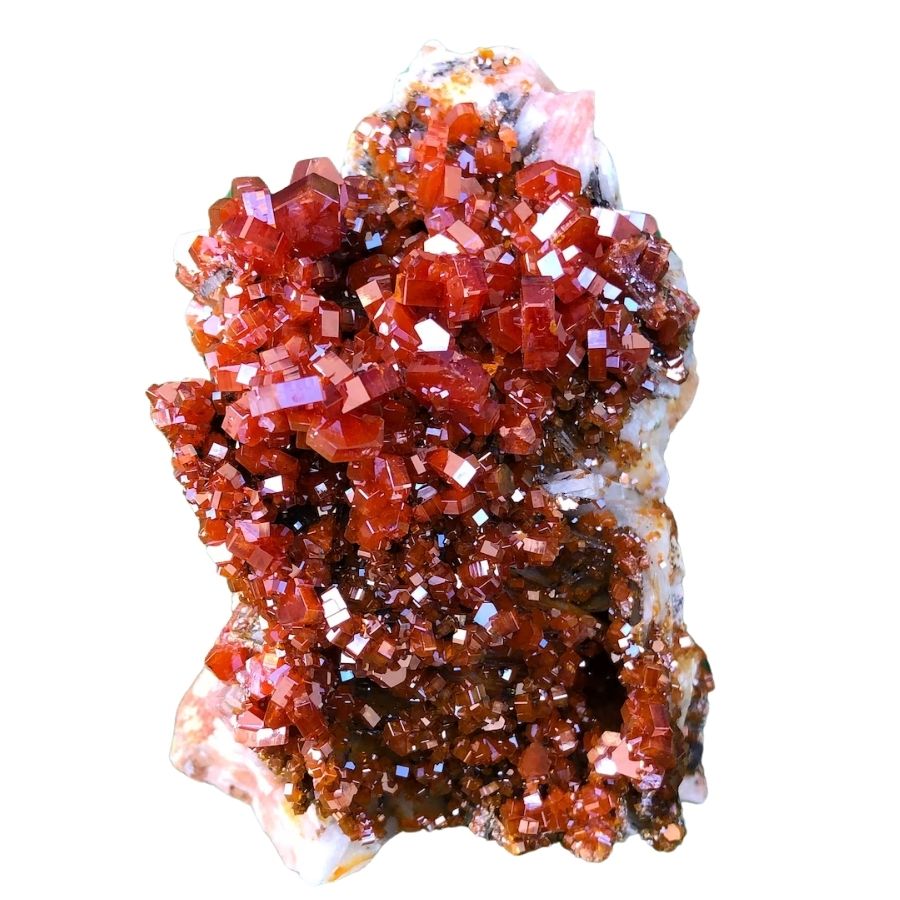
Vanadinite is a bright red to orange mineral that’s part of the apatite group of phosphates. It’s known for its beautiful hexagonal crystals that can form in clusters.
This mineral is not just a pretty face; it has some important practical uses too. It’s a significant source of vanadium, which is used in making strong, corrosion-resistant steel alloys.
In addition to steel production, vanadinite is also used in the manufacturing of dyes and in the chemical industry. Its role in these industries highlights how minerals can be essential in everyday products and processes.
Fun Fact:
Vanadinite is a rare secondary mineral, formed through the chemical transformation of primary lead minerals in arid environments.
Its occurrence is limited, making it a unique find due to the specific conditions required for its formation.Where vanadinite is found
Vanadinite is often discovered in dry, desert regions where it forms by the oxidation of lead ore deposits. Some well-known places for finding vanadinite include Morocco, Arizona in the United States, and Namibia.
How you can identify vanadinite
Color
Vanadinite is renowned for its striking color range, typically showcasing vibrant shades of red, orange, and brown. This vivid coloration, often in bright red or deep orange hues, is one of its most distinguishing and appealing characteristics.
Hardness
Vanadinite falls in the range of 3 to 4 on the Mohs scale of mineral hardness, indicating that it’s relatively soft compared to many other minerals. This level of hardness means it can be scratched by materials like a steel knife or harder minerals.
Clarity
Vanadinite typically exhibits a translucent to opaque clarity, meaning that it allows some light to pass through but is not completely clear.
Refractive index
Vanadinite has a refractive index in the range of approximately 2.35 to 2.41, which is relatively high and contributes to its notable brilliance and luster.
Specific gravity
Vanadinite has a specific gravity typically between 6.6 and 7.2. This density makes vanadinite noticeably heavier than many other minerals of similar size.
Wulfenite – PbMoO4
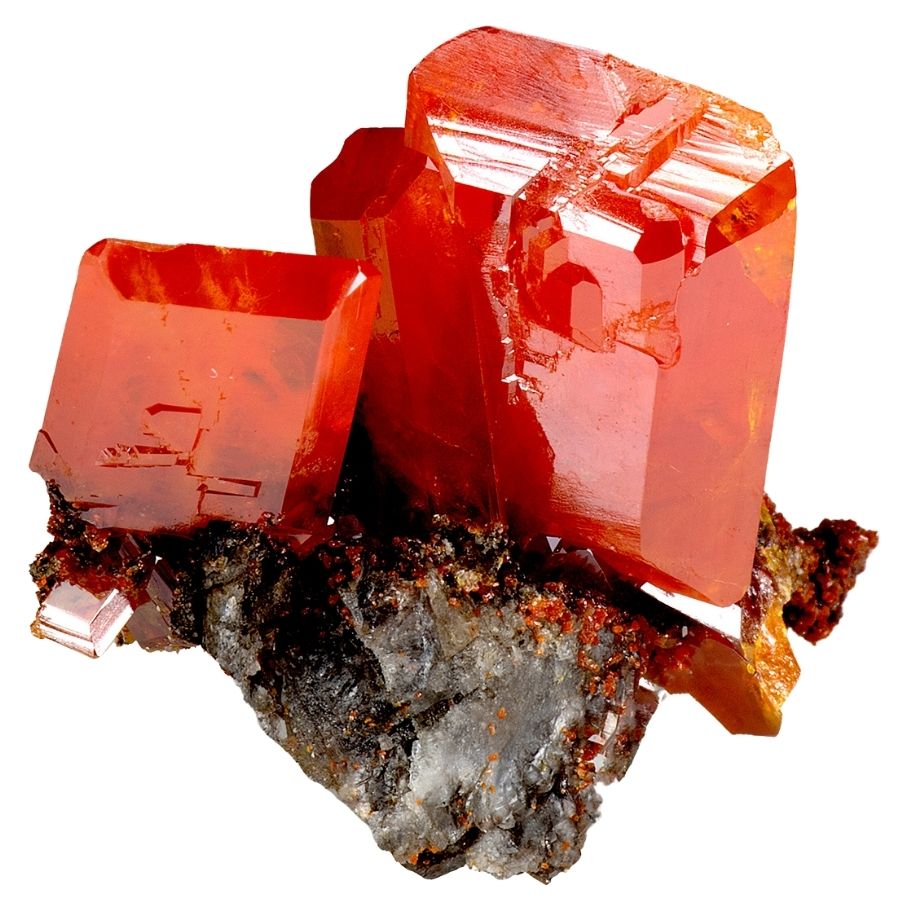
Wulfenite is a unique mineral known for its thin, tabular crystals and vibrant colors, which range from yellow-orange to red-orange. Its striking appearance makes it a favorite among mineral collectors and enthusiasts.
Beyond its beauty, wulfenite has practical uses too. It’s an important source of molybdenum, a metal used to strengthen steel and make high-temperature alloys.
In addition to its industrial role, wulfenite is also used in the production of certain chemicals and lubricants. This shows how minerals like wulfenite are not just for display, but play a role in various applications in our daily lives.
Fun Fact:
The name "wulfenite" honors Austrian scientist Franz Xavier von Wulfen, with its first recorded use dating back to 1845. This naming pays tribute to von Wulfen's contributions to the field of mineralogy.Where wulfenite is found
Wulfenite is often found in arid regions where it forms in the oxidation zones of lead deposits. Some notable places for finding wulfenite include Arizona in the United States, Mexico, and Namibia.
How you can identify wulfenite
Color
Wulfenite is admired for its vibrant color palette, predominantly featuring bright shades of yellow, orange, and red. These colors can range from a deep, rich red-orange to a bright, lemon-yellow.
Hardness
Wulfenite is a relatively soft mineral, rating about 3 on the Mohs scale of hardness. This means it can be easily scratched by harder substances, like a steel knife or a piece of quartz.
Clarity
Wulfenite typically exhibits a range of clarity from translucent to almost opaque, allowing varying degrees of light to pass through its crystals.
Refractive index
Wulfenite has a notably high refractive index, ranging between 2.28 and 2.40, which contributes to its sparkling appearance.
Specific gravity
Wulfenite has a specific gravity typically between 6.5 and 7.0, categorizing it as a quite dense mineral. This high density means that wulfenite feels notably heavier than many other minerals of a similar size when held.

